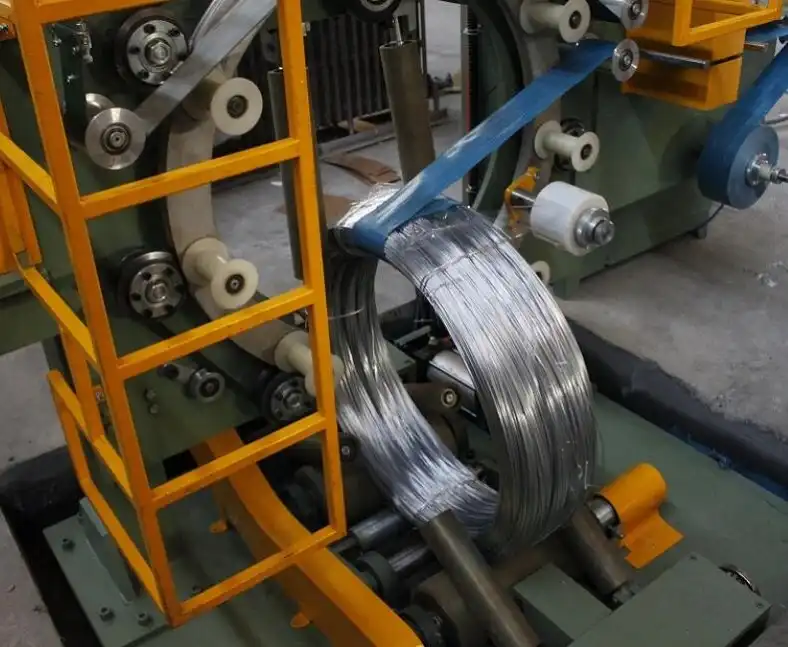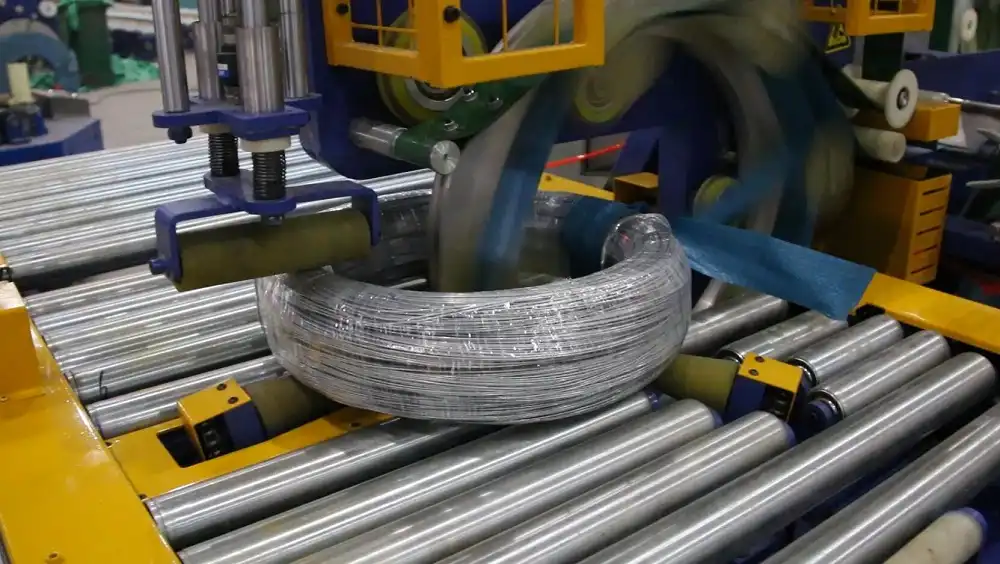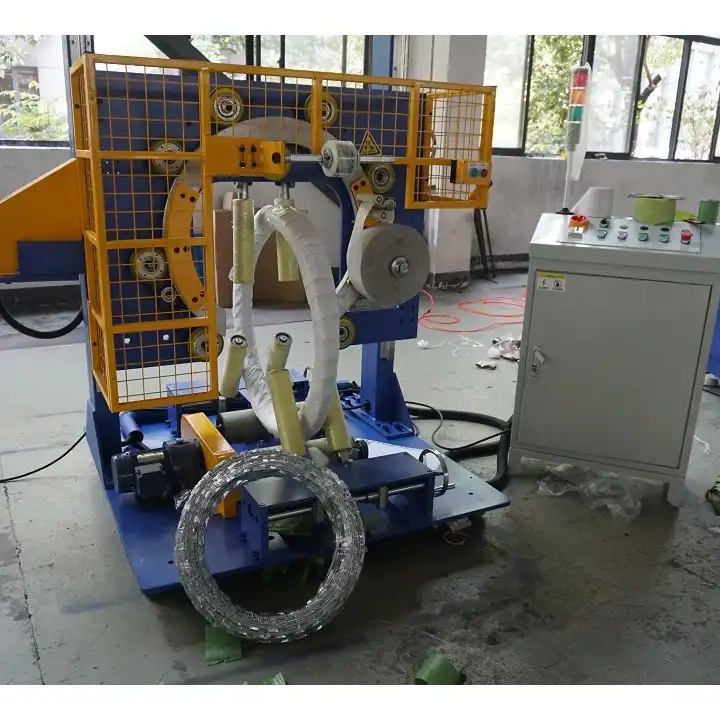Optimizing Wire Coil Packaging: Integrating Compression and Automated Strapping
Handling and packaging large, heavy wire coils presents significant challenges in the metal fabrication and processing industries. Ensuring these coils are stable, secure, and protected during storage and transit is crucial for product integrity, logistical efficiency, and workplace safety. An integrated approach combining wire coil compression with automated strapping offers a robust solution to meet these demands.

The Challenge of Wire Coil Packaging
Wire coils, particularly large-diameter or heavy-gauge ones, can be inherently unstable. Improper packaging can lead to:
- Coil telescoping or collapsing during handling.
- Damage to the wire surface or edges.
- Difficulties in stacking and storage.
- Safety hazards during loading, unloading, and transport.
Manual packaging methods are often time-consuming, labor-intensive, and can result in inconsistent package quality. Automated systems address these issues directly.
Understanding the Integrated Wire Coil Packaging Process
A typical automated system involves two key stages working in sequence: compression and strapping.
Step 1: Wire Coil Compression for Stability and Handling
Before strapping, the wire coil often passes through a compressing machine. This unit applies significant vertical pressure to:
- Densify the Coil: Reduces the overall volume, creating a tighter, more compact package.
- Enhance Stability: Minimizes the potential for shifting wires within the coil.
- Facilitate Spool Removal: In some applications, compression helps secure the coil structure sufficiently so that an internal spool or core can be removed before or during the strapping process, if required by the specific packaging configuration.

automatic steel wire coil packing machine2 Step 2: Automated Strapping for Secure Unitization
Following compression, the coil moves to the automatic strapping station. Here, high-tensile strapping material (typically steel or high-strength plastic) is applied circumferentially around the coil. The process generally involves:
- Strap Feeding: The machine feeds the required length of strap around the compressed coil.
- Tensioning: The strap is pulled tight to a pre-set tension level, ensuring the coil remains compact and secure. Proper tension is critical – too loose, and the coil isn't secure; too tight, and the wire product could be damaged.
- Sealing: The ends of the strap are joined, usually through a heat seal (for plastic straps) or a mechanical seal/crimp (for steel straps).
- Cutting: The strap is cut, completing the cycle.
This integrated process ensures the coil maintains its compressed form and is securely unitized for handling.
(Video: Example of an automatic packing solution integrating wire coil compressing and strapping capabilities.)
Selecting the Right Compression and Strapping System
Choosing the appropriate equipment requires careful consideration of several factors:

Strapping Head Technology and Configuration
Modern strapping heads are designed for reliability and specific performance needs. Consider factors like seal type (e.g., friction weld for PET/PP, notch/crimp for steel), maintenance requirements, and suitability for the operating environment. The overall machine configuration might involve indexing tables, conveyors, or robotic integration depending on the required throughput and level of automation.
Choosing the Appropriate Strapping Material
The choice between steel, polypropylene (PP), and polyester (PET) strapping depends on the coil weight, handling requirements, and environmental conditions:
- Steel Strapping: Offers the highest tensile strength and rigidity, ideal for very heavy or potentially sharp-edged coils. However, it can rust and may require more safety precautions during handling and removal.
- Polyester (PET) Strapping: Provides high strength and retains tension well, making it a viable alternative to steel in many heavy-duty applications. It's resistant to moisture and UV light.
- Polypropylene (PP) Strapping: Suitable for lighter-duty coils or bundling applications. It's more economical but has lower tensile strength and can elongate more under load compared to PET or steel.
Critical Strapping Parameters: Width, Tension, and Speed
- Strap Width: Common widths for heavy coils range from 1/2 inch (12.7mm) to 1 1/4 inch (32mm) or more. Wider straps generally distribute load better.
- Tensioning Power: The system must provide adequate and consistent tension. Modern machines offer precise electronic tension control to prevent product damage while ensuring load security.
- Cycle Speed: The machine's strapping speed (cycles per minute) directly impacts overall packaging throughput. This needs to align with production rates.
System Integration and Automation Level
Evaluate how the compressor and strapper integrate. A seamless connection, often managed by a central PLC (Programmable Logic Controller), ensures efficient transfer and operation. Consider the overall level of automation needed, from semi-automatic (requiring operator initiation) to fully automatic (integrated into a production line). The solution may include features like automatic spool handling, mentioned earlier as provided by this wire coil strapping machine.
Streamlining the Packaging Workflow
Maximizing the benefits of automated equipment involves optimizing the entire workflow:
Facility Layout and Material Flow
Ensure adequate floor space for the machinery, coil staging (both pre- and post-packaging), and safe movement of handling equipment. The layout should facilitate a logical flow from the end of the production line through compression and strapping to the shipping or storage area.
Safe and Efficient Coil Handling Equipment
Use appropriate equipment like overhead cranes with C-hooks, specially designed forklifts, or heavy-duty pallet jacks for moving large wire coils. Safety protocols for lifting and maneuvering heavy loads are paramount.
Operator Training and Safety Protocols
Properly train operators on machine operation, routine maintenance, troubleshooting common issues, and all safety procedures, including lockout/tagout protocols during maintenance.
Measurable Benefits of Automated Wire Coil Packaging
Implementing an integrated compression and strapping system yields significant operational advantages:
- Enhanced Workplace Safety: Reduces manual handling of heavy coils and sharp strapping, minimizing risks of strains, cuts, and other injuries. Properly secured loads are safer to transport.
- Improved Load Security: Consistent tensioning and secure seals prevent coil damage and ensure stability during transit, reducing customer complaints and claims.
- Increased Operational Throughput: Automation significantly speeds up the packaging process compared to manual methods, eliminating bottlenecks and increasing overall output.
- Optimized Labor Utilization: Frees up personnel previously engaged in manual strapping for more value-added tasks within the facility.
- Consistent Packaging Standards: Automated systems apply straps with uniform tension and placement every time, ensuring adherence to internal or customer-specific packaging specifications.

razor wire wrapping machine1 Conclusion
For facilities handling significant volumes of wire coils, transitioning from manual methods to an automated compression and strapping solution is a strategic investment. By carefully selecting equipment based on application needs – considering factors like strapping material, tension control, and integration – and optimizing the surrounding workflow, manufacturers can achieve substantial improvements in packaging efficiency, load security, workplace safety, and overall productivity. This investment supports higher throughput, reduces operational costs, and ultimately enhances competitiveness in the demanding metals industry.
For further information on packaging standards, consult authoritative resources such as ASTM International which develops standards for various materials and packaging applications.

